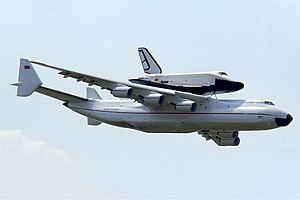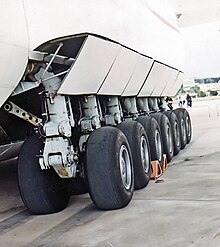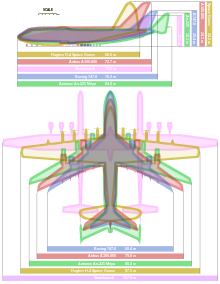Antonov An-225 Mriya
| An-225 Mriya | |
|---|---|

| |
| The An-225 with Buran atop, at the Paris Air Show in 1989. | |
| Role | Strategic airlifter |
| National origin | Soviet Union / Ukraine |
| Manufacturer | Antonov |
| First flight | 21 December 1988 |
| Status | In service |
| Primary user | Antonov Airlines |
| Produced | 1988 |
| Number built | 1 |
| Developed from | Antonov An-124 |
The Antonov An-225 Mriya ([Антонов Ан-225 Мрія] Error: {{Lang-xx}}: text has italic markup (help), Dream, NATO reporting name: "Cossack") is a strategic airlift cargo aircraft, designed by the Soviet Union's Antonov Design Bureau in the 1980s. The An-225's name, Mriya (Мрiя) means "Dream" (Inspiration) in Ukrainian. It is powered by six turbofan engines and is the longest and heaviest aircraft ever made with a maximum takeoff weight of 640 tonnes. It also has the largest wingspan of any aircraft in operational service. The single example built bears the civil registration UR-82060 of its Ukrainian operator.[1] A second airframe was partially built; its completion has been halted due to lack of funding and interest.
The Antonov An-225, originally developed specifically to transport the Buran spaceplane, was an enlargement of the successful Antonov An-124. The first An-225 was completed in 1988 and remains in commercial operation with Antonov Airlines carrying oversized payloads.[2] The airlifter holds the absolute world records for an airlifted single item payload of 189,980 kilograms (418,834 pounds),[3][4] and an airlifted total payload of 253,820 kilograms (559,577 pounds).[5][6] It has also transported a payload of 247,000 kilograms (545,000 pounds) on a commercial flight.[7]
Development

The Antonov An-225 was designed to airlift the Energia rocket's boosters and the Buran space shuttle for the Soviet space program. It was developed as a replacement for the Myasishchev VM-T. The An-225's original mission and objectives are almost identical to that of the United States' Shuttle Carrier Aircraft.[8][9]

The An-225 first flew on 21 December 1988 with a 74-minute flight from Kiev. The aircraft was on static display at the Paris Air Show in 1989 and it flew during the public days at the Farnborough air show in 1990. Two aircraft were ordered, but only one An-225 (registration CCCP-82060 later UR-82060[10]) was finished. It can carry ultra-heavy and oversize freight, up to 250,000 kg (550,000 lb) internally,[8] or 200,000 kg (440,000 lb) on the upper fuselage. Cargo on the upper fuselage can be 70 metres (230 ft) long.[11]
A second An-225 was partially built during the late 1980s for the Soviet space program. The second An-225 included a rear cargo door and a redesigned tail with a single vertical stabilizer. It was planned to be more effective for cargo transportation.[12] Following the collapse of the Soviet Union in 1991 and the cancellation of the Buran space program, the lone operational An-225 was placed in storage in 1994.[13] The six Ivchenko Progress engines were removed for use on An-124s, and the second uncompleted An-225 airframe was also stored. The first An-225 was later re-engined and put into service.[6][14]
By 2000, the need for additional An-225 capacity had become apparent, so the decision was made in September 2006 to complete the second An-225. The second airframe was scheduled for completion around 2008,[15] then delayed. By August 2009, the aircraft had not been completed and work had been abandoned.[2][16] In May 2011 Antonov CEO is reported to have said that the completion of a second An-225 Mriya transport aircraft with a carrying capacity of 250 tons requires at least $300 million, but if the financing is provided, its completion could be achieved in three years.[17] According to different sources, the second jet is 60–70% complete.[18]
Design

Based on Antonov's earlier An-124, the An-225 has fuselage barrel extensions added fore and aft of the wings. The wings also received root extensions to increase span. Two more Ivchenko Progress D-18T turbofan engines were added to the new wing roots, bringing the total to six. An increased-capacity landing gear system with 32 wheels was designed, some of which are steerable, enabling the aircraft to turn within a 60 m (200 ft) wide runway. Like its An-124 predecessor, the An-225 has nosegear designed to kneel so cargo can be more easily loaded and unloaded.[6] The An-124’s rear cargo door and ramp were removed to save weight and the empennage was changed from a single vertical stabilizer to a twin tail with an oversized horizontal stabilizer. The twin tail was essential to enable the plane to carry large, heavy external loads that would disturb the airflow around a conventional tail. Unlike the An-124, the An-225 was not intended for tactical airlifting and is not designed for short-field operation.[8]

Initially the 225 had a maximum gross weight of 600 t (1,300,000 lb) but the aircraft underwent modifications from 2000 to 2001, at a cost of US$20M, with a reinforced floor that increased the maximum gross weight to 640 t (1,410,000 lb).[19][20][21]
Both the earlier and later takeoff weights establish the An-225 as the world's heaviest aircraft, being heavier than the double-deck Airbus A380 even though Airbus plans to surpass the An-225's maximum landing weight with 591.7 tonnes (1,304,000 lb) for the A380.[22] The Boeing 747 Dreamlifter has a bigger cargo hold at 1,840m3 (65,000 cubic feet).[23] The Hughes H-4 Hercules, known as the "Spruce Goose", had a greater wingspan and a greater overall height, but was 20% shorter, and due to the materials used in its construction, also lighter. In addition, the Spruce Goose flew only once, making the An-225 the largest aircraft in the world to fly multiple times.[6][24]
The pressurized cargo hold is 1,300 m3 (46,000 cu ft) in volume; 6.4 m (21 ft) wide, 4.4 m (14 ft) high, and 43.35 m (142.2 ft) long[6][25][26] — longer than the first flight of the Wright Flyer.[27][28][29]
Operational history

As the Soviet space program was in its last years, the An-225 was employed as the prime method of transporting the Buran Shuttle.[24]
Antonov commercialization
In the late 1970s, efforts commenced by the Soviet government to generate revenue from its military assets. In 1989, a holding company was set up by the Antonov Design Bureau as a heavy airlift shipping corporation under the name "Antonov Airlines", based in Kiev, Ukraine and operating from London Luton Airport in partnership with the Air Foyle HeavyLift.[11][30]
The company initiated operations with a fleet of four An-124-100s and three Antonov An-12s, but by the late 1990s a need for aircraft larger than the An-124 became apparent. In response, the original An-225 was re-engined, modified for heavy cargo transport, and placed back in service under the management of Antonov Airlines.

On 23 May 2001, the An-225 received its type certificate from the Interstate Aviation Committee Aviation Register (IAC AR).[31] On 11 September 2001, carrying 4 main battle tanks[6] at a record load of 253.82 tonnes (279.79 short tons) of cargo,[5] the An-225 flew at an altitude of up to 10,750 m (35,270 ft)[32] over a closed circuit of 1,000 km (620 mi) at a speed of 763.2 km/h (474.2 mph).[33][34]
Regular commercial flights
The type's first flight in commercial service departed from Stuttgart, Germany on 3 January 2002, and flew to Thumrait, Oman with 216,000 prepared meals for American military personnel based in the region. This vast number of ready meals was transported on some 375 pallets and weighed 187.5 tons.[35]
The An-225 has since become the workhorse of the Antonov Airlines fleet, transporting objects once thought impossible to move by air, such as locomotives and 150-ton generators. It has become an asset to international relief organizations for its ability to quickly transport huge quantities of emergency supplies during disaster relief operations.[36]
The An-225 has been contracted by the Canadian and U.S. governments to transport military supplies to the Middle East in support of Coalition forces.[36] In November 2004, FAI placed the An-225 in the Guinness Book of Records for its 240 records. An example of the cost of shipping cargo by An-225 was over 2 million DKK (approx. €266,000) for flying a chimney duct from Denmark to Kazakhstan in 2008.[37]
On 11 August 2009, the heaviest single cargo item ever sent via air freight was loaded onto the Antonov 225. At 16.23 metres (53.2 ft) long and 4.27 metres (14.0 ft) wide, the consignment–a generator for a gas power plant in Armenia and its loading frame–weighed in at a record 189 tonnes (417,000 lb).[3][4] Also during 2009, the An-225 was painted in a new blue and yellow paint scheme,[38] after Antonov ceased cooperation with AirFoyle and partnered with Volga-Dnepr in 2006.[39]
On 11 June 2010, the An-225 carried the world's longest piece of air cargo, when it flew two new 42-meter test wind turbine blades from Tianjin, China to Denmark.[40]
Aerial launch project revival
In April 2013, the Russian government announced its plans to revive Soviet-era air launch projects that would use a purposely built modification to the An-225 as a midair launchpad.[41]
Operators
- Antonov Airlines for Soviet Buran program, the company (and aircraft) passed to Ukraine after the collapse of the Soviet Union.
Specifications (An-225)

Data from Vectorsite,[8] Antonov's Heavy Transports,[42] and others[6][14][25][26]
General characteristics
- Crew: 6
- Length: 84 m (275 ft 7 in)
- Wingspan: 88.4 m (290 ft 0 in)
- Height: 18.1 m (59 ft 5 in)
- Wing area: 905 m2 (9,740 sq ft)
- Aspect ratio: 8.6
- Empty weight: 285,000 kg (628,317 lb)
- Max takeoff weight: 640,000 kg (1,410,958 lb)
- Fuel capacity: 300000 kg
- Cargo hold – volume 1,300m3, length 43.35m, width 6.4m, height 4.4m
- Powerplant: 6 × ZMKB Progress D-18 turbofans, 229.5 kN (51,600 lbf) thrust each
Performance
- Maximum speed: 850 km/h (530 mph, 460 kn)
- Cruise speed: 800 km/h (500 mph, 430 kn)
- Range: 15,400 km (9,600 mi, 8,300 nmi) with maximum fuel; range with maximum payload: 4,000 km (2,500 mi)
- Service ceiling: 11,000 m (36,000 ft)
- Wing loading: 662.9 kg/m2 (135.8 lb/sq ft)
- Thrust/weight: 0.234

Notable appearances in media
See also
Related development
Aircraft of comparable role, configuration, and era
- Airbus Beluga
- Boeing 747-8F
- Boeing 747 Shuttle Carrier Aircraft
- Boeing 747 Large Cargo Freighter
- Lockheed C-5 Galaxy
- Myasishchev VM-T
Related lists
References
- ^ Groening, Olav. "UR-82060 Antonov Airlines (Antonov Design Bureau) Antonov An-225 Mriya; Photo ID: 127918". Planespotters.net. Planespotters.net. Retrieved 21 May 2013.
- ^ a b "World's largest aircraft, An-225, emerges to set new lift record". Flight International, 17 August 2009.
- ^ a b Cargo manifest picture Air Cargo News 13 November 2009. Retrieved: 30 May 2012.
- ^ a b Ukraine's An-225 aircraft sets new record for heaviest single cargo item transported by air, Eye for Transport, 18 August 2009.
- ^ a b "Payload record in the official FAI database". Retrieved 2 May 2013.
- ^ a b c d e f g An-225 (An-225-100) "Мрiя". Russian Aviation Museum, 20 October 2001. Retrieved: 31 October 2010. Cite error: The named reference "ramAn225" was defined multiple times with different content (see the help page).
- ^ "An-225 sets new record for payload". Retrieved 2 May 2013.
- ^ a b c d Greg Goebel. "Antonov An-225 Mriya ("Cossack")". The Antonov Giants: An-22, An-124, & An-225. Retrieved 21 August 2012.
- ^ Greg Goebel. "The Soviet Buran shuttle program". Postscript: The Other Shuttles. Retrieved 21 August 2012.
- ^ Photo on airliners.net
- ^ a b "Mriya". Antonov ASTC. Retrieved 27 May 2004.
- ^ Kaplan, Philip. "Big Wings".
{{cite journal}}: Cite journal requires|journal=(help)CS1 maint: postscript (link) - ^ Antonov An-225 Mriya. Airliners.net.
- ^ a b "Antonov An-225 Mriya (Cossack) Heavy Lift Strategic Long-Range Transport" Military Factory, 23 August 2012. Retrieved: 6 September 2012.
- ^ Antonov An-225 Mriya Aircraft History, Facts and Pictures. Aviationexplorer
- ^ The Mriya 2: Pictures. Buran-energia.com
- ^ "$300m needed for completion of An-225 transport, says Antonov CEO"
- ^ "Ukraine may finish the construction of second An-225 Mriya transport aircraft – News – Russian Aviation". Ruaviation.Com. Retrieved 6 April 2012.
- ^ Forward, David C: Antonov's Dream Machine, p. 23. Airways magazine, June 2004
- ^ Spaeth, Andreas: When size matters, p. 29. Air International magazine, December 2009
- ^ Gordon, Yefim; Dmitriy and Sergey Komissarov: "The Six-Engined Dream", page 76. Antonov's Heavy Transports: The An-22, An-124/225 and An-70. Midland, 2004. ISBN 1-85780-182-2.
- ^ "Airbus Reveals A380-linked Pilot Systems Secrets". Flight International. 3 June 2009.
{{cite journal}}: CS1 maint: postscript (link) - ^ ""Flight Test Program is under way for 747 Large Cargo Freighter." Boeing, November 2006. Retrieved: 29 September 2012.
- ^ a b "Antonov An-225 Mryia (Cossack)". The Aviation Zone. Retrieved 1 July 2011. Cite error: The named reference "avzone" was defined multiple times with different content (see the help page).
- ^ a b "AN-225 Mriya" GlobalSecurity.org. Retrieved: 6 September 2012.
- ^ a b "Antonov An 225" Air Charter Service. Retrieved: 6 September 2012.
- ^ "Milestones of Flight – 1903 Wright Flyer" — Smithsonian National Air and Space Museum
- ^ "100 Years Ago, the Dream of Icarus Became Reality." FAI NEWS, December 17, 2003. Retrieved: January 5, 2007.
- ^ Lindberg, Mark. "Century of Flight." Wings of History Museum, 2003. Retrieved: August 27, 2011.
- ^ "An-225 Mriya, NATO: Cossack". Goleta Air & Space Museum. Retrieved 31 March 2004.
- ^ Template:Wayback
- ^ "Height record with 250t payload in the FAI database".
- ^ "Speed record with 250t payload over 1000km closed circuit in the official FAI database". Retrieved 2 May 2013.
- ^ "Special planes: The Antonov-225 "Mriya"". European Tribune. 8 April 2006.
{{cite journal}}: Cite journal requires|journal=(help)CS1 maint: postscript (link) - ^ "Antonov Airlines:An-225 Mriya". AirFoyle.
- ^ a b "Antonov An-225". Aircraft-Info.net. Archived from the original on 1 April 2004. Retrieved 15 February 2004.
- ^ Steelcon News. steelcon.com. Retrieved: 13 June 2010.
- ^ "Photo of the AN-225 in new paint scheme". Spotters.net. 2009. Retrieved 30 December 2009.
- ^ Ingram, Frederick C. Volga-Dnepr Group answers.com. Retrieved: 24 July 2010.
- ^ Record breaking journey Renewable Energy Sources, 11 June 2010. Pictures: [1] [2] Retrieved: 13 June 2010.
- ^ "Правительство задумалось о "Воздушном старте"". Interfax (in Russian). 23 April 2013. Retrieved 29 April 2013.
- ^ Gordon, Yefim (2004). Antonov's Heavy Transports: Big Lifters for War & Peace. Midland Publishing. ISBN 1-85780-182-2.
External links
- Official An-225 web page
- An-225 – buran-energia.com
- An-225 on YouTube The worlds biggest planes: Antonov An-225 in comparison with Airbus A380-800, Airbus A340-600 and Boeing 747-400
- An-225 on YouTube Landing In Crosswind
- Second Antonov An-225 Mriya (line no. 01-02) under construction at Aviant-Kiev Aviation Plant. Kiev-Svyatoshino (UKKT), Ukraine, 19 September 2004
- Second Antonov An-225 Mriya (line no. 01-02) (front view) under construction at Aviant-Kiev Aviation Plant. Kiev-Svyatoshino (UKKT), Ukraine, 20 August 2008
- Second Antonov An-225 Mriya (line no. 01-02) (side view) under construction at Aviant-Kiev Aviation Plant. Kiev-Svyatoshino (UKKT), Ukraine, 20 August 2008
- Payloads
